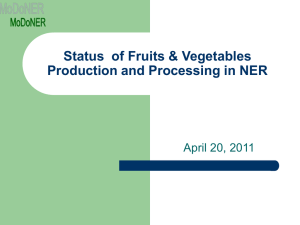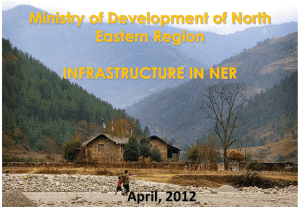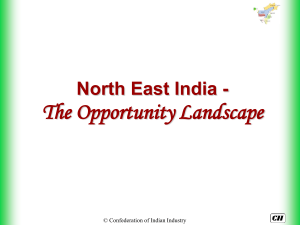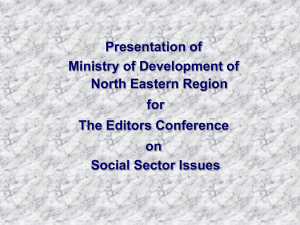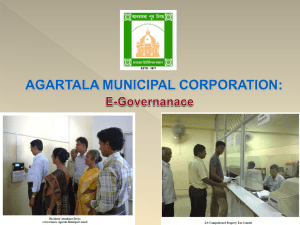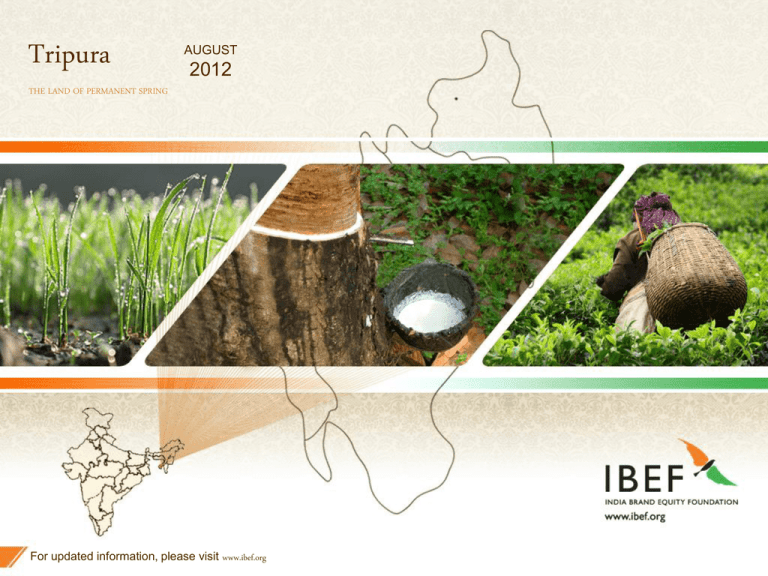
Tripura
AUGUST
2012
THE LAND OF PERMANENT SPRING
For updated information, please visit www.ibef.org
1
Tripura
AUGUST
2012
THE LAND OF PERMANENT SPRING
Contents
Tripura – An Introduction
Infrastructure Status
Business Opportunities
Doing Business in Tripura
State Acts & Policies
For updated information, please visit www.ibef.org
2
Tripura
AUGUST
2012
THE LAND OF PERMANENT SPRING
Tripura Factfile
→
→
Tripura is bounded on the North, West, South and South-east by Bangladesh, whereas
in the East it has a common boundary with Assam and Mizoram.
Bengali and Kokborok/Tripuri are the official languages of the state. The medium of
instruction in schools is either Bengali or English.
→
Tripura has four administrative districts: North Tripura, West Tripura, South
Tripura and Dhalai. Agartala is the state capital and the state’s largest city. The key
towns in the state are Kailashahar, Udaipur, Khumulwng, Kamalpur, Ambassa,
Khowai and Sabroom.
→
The main rivers flowing through Tripura are Gomati, Manu, Khowai, Feni, Doloi,
Muhuri and Haora.
Parameters
Tripura
Capital
Agartala
Geographical area (sq km)
10,492
Administrative districts (No)
4
Population density (persons per sq km)*
350
Total population (million)*
3.6
Male population (million)*
1.8
Female population (million)*
1.8
Sex ratio (females per 1,000 males)*
961
Literacy rate (%)*
87.8
Sources: Government of Tripura Website, www.tripura.nic.in *Provisional Data – Census 2011
For updated information, please visit www.ibef.org
TRIPURA – AN INTRODUCTION
3
Tripura
AUGUST
2012
THE LAND OF PERMANENT SPRING
Tripura in Figures … (1/2)
Parameter
Tripura
All-States
Source
GSDP as a percentage of all states’ GSDP
0.25
100
CMIE, 2010-11, current prices
Average GSDP growth rate (%)*
11.8
15.9
CMIE, 2004-05 to 2010-11, current prices
1,060.1
1,324.3
CMIE, 2010-11, current prices
265.0
199,627.0
Central Electricity Authority, as of March 2012
8,247,010^
903,727,208
Telecom Regulatory Authority of India, as of
January 2012
53,399^
13,350,938
Ministry of Communications & Information
Technology, as of December 2011
400
71,772
Ministry of Road Transport & Highways, Annual
Report 2011-12
1
133
Airport Authority of India
Economy
Per capita GSDP (US$)
Physical Infrastructure
Installed power capacity (MW)
Wireless subscribers (No)
Broadband subscribers (No)
National Highway length (km)
Airports (No)
*Calculated in Indian Rupee Terms
^Combined figures for the Northeast states comprising Arunachal Pradesh, Manipur, Meghalaya, Mizoram, Nagaland and Tripura
For updated information, please visit www.ibef.org
TRIPURA – AN INTRODUCTION
4
Tripura
AUGUST
2012
THE LAND OF PERMANENT SPRING
Tripura in Figures … (2/2)
Parameter
Tripura
All-States
Source
Literacy rate (%)
87.8
74.0
Provisional Data – Census 2011
Birth rate (per 1,000 population)
14.9
22.1
SRS Bulletin (www.censusindia.gov.in), 2011
FDI equity inflows (US$ billion)
0.07*
160.0
Department of Industrial Policy & Promotion,
April 2000 to January 2012
Outstanding investments (US$ billion)
14.8
11,318.3
CMIE (2011-12)
Social Indicators
Investments
*FDI inflows for RBI’s (Reserve Bank of India’s) Guwahati-region, which includes Assam, Arunachal Pradesh, Manipur,
Meghalaya, Mizoram, Nagaland and Tripura.
SRS: Sample Registration System
For updated information, please visit www.ibef.org
TRIPURA – AN INTRODUCTION
5
Tripura
AUGUST
2012
THE LAND OF PERMANENT SPRING
Advantage Tripura … (1/2)
Endowed with Natural Resources
Tripura is rich in natural resources such as natural gas, rubber, tea and medicinal plants. It is also known for its vibrant food processing,
bamboo and sericulture industries.
International Trade Opportunities
Tripura acts as a gateway between Northeast India and Bangladesh. This offers immense potential for international trade.
Improving Connectivity and Infrastructure
Tripura is connected with the rest of Northeast India by National Highway (NH)-44. Improved rail, air connectivity and establishment of
trade routes have further facilitated the trade.
For updated information, please visit www.ibef.org
TRIPURA – AN INTRODUCTION
6
Tripura
AUGUST
2012
THE LAND OF PERMANENT SPRING
Advantage Tripura … (2/2)
Untapped Sectors
The state has several potential but unexplored sectors such as organic spices, bio-fuel and eco-tourism.
Availability of Skilled Workforce
At 87.8 per cent, Tripura’s literacy rate is higher than the national average rate. The state has institutes such as National Institute of
Technology (NIT) and Tripura Institute of Technology (TIT) which provide skilled manpower to the industries.
Tourist Destination
With its pleasant climate and scenic landscape, Tripura is a favoured tourist destination. The state offers tourists a variety of sites to visit,
such as temples, rivers and rock carvings.
For updated information, please visit www.ibef.org
TRIPURA – AN INTRODUCTION
7
Tripura
AUGUST
2012
THE LAND OF PERMANENT SPRING
Economic Snapshot – GSDP
→
At current prices, the total Gross State Domestic Product (GSDP) of Tripura was
about US$ 4.1 billion in 2011-12.
→
The state’s GSDP grew at an average annual rate of 11.6 per cent between 2004-05
and 2011-12.
Tripura’s GSDP
2011-12
4.1
3.8
2010-11
2009-10
3.2
2008-09
2.9
2007-08
2.9
2006-07
2005-06
2.2
2004-05
1.9
0
0.5
1
1.5
2
2.5
US$ billion
For updated information, please visit www.ibef.org
CAGR
11.6%
2.4
3
3.5
4
4.5
Source: CMIE
TRIPURA – AN INTRODUCTION
8
Tripura
AUGUST
2012
THE LAND OF PERMANENT SPRING
Economic Snapshot – NSDP
→
The Net State Domestic Product (NSDP) of Tripura was about US$ 3.8 billion in
2011-12.
→
Tripura’s NSDP grew at an average rate of 11.2 per cent between 2004-05 and 201112.
Tripura’s NSDP
2011-12
3.8
2010-11
3.5
2009-10
2.9
2008-09
2.7
2007-08
2.6
2006-07
2.2
2005-06
2.0
2004-05
1.8
0
0.5
1
1.5
2
US$ billion
For updated information, please visit www.ibef.org
CAGR
11.2%
2.5
3
3.5
4
Source: CMIE
TRIPURA – AN INTRODUCTION
9
Tripura
AUGUST
2012
THE LAND OF PERMANENT SPRING
Economic Snapshot – Per Capita GSDP
→
→
The state’s per capita GSDP in 2011-12 was US$ 1,130.3 as compared to US$ 591.4
in 2004-05.
Per Capita GSDP
1,200
Per capita GSDP increased at an average annual rate of 9.7 per cent between 2004-05
and 2011-12.
1,000
843.8
US$
841.0
910.1
702.3
800
600
1,060.1 1,130.3
CAGR
9.7%
591.4
654.5
400
200
0
Source: CMIE
For updated information, please visit www.ibef.org
TRIPURA – AN INTRODUCTION
10
Tripura
AUGUST
2012
THE LAND OF PERMANENT SPRING
Economic Snapshot – Per Capita NSDP
→
→
The state’s per capita NSDP in 2011-12 was US$ 1,058.6 as compared to US$ 542.6
in 2004-05.
Per Capita NSDP
1,200
The per capita NSDP increased at an average rate of 10.0 per cent between 2004-05
and 2011-12.
CAGR
10.0%
1,000
773.1
800
US$
600
986.7
542.6
602.2
775.1
1,058.6
842.6
642.2
400
200
0
Source: CMIE
For updated information, please visit www.ibef.org
TRIPURA – AN INTRODUCTION
11
Tripura
AUGUST
2012
THE LAND OF PERMANENT SPRING
Economic Snapshot – Percentage Distribution
of GSDP
→
→
→
→
In 2011-12, the tertiary sector contributed 51.8 per cent to the state’s GSDP, followed
by the secondary sector (28.6 per cent) and the primary sector (19.6 per cent).
The secondary sector registered the highest growth rate of 15.7 per cent between
2004-05 and 2011-12; driven by manufacturing, construction and electricity, gas &
water supply.
The tertiary sector grew at an average rate of 12.3 per cent during the period 200405 and 2011-12. Its growth was driven by trade, hotels, real estate, finance, insurance,
transport, communications and other services.
The primary sector grew at an average rate of 7.3 per cent between 2004-05 and
2011-12.
Percentage Distribution of GSDP
100
90
80
70
60
50
40
30
20
10
0
CAGR
50.7
51.8
12.3%
28.6
15.7%
26.5
19.6
7.3%
2004-05
2011-12
22.8
Primary Sector
Secondary Sector
Tertiary Sector
Source: CMIE
For updated information, please visit www.ibef.org
TRIPURA – AN INTRODUCTION
12
Tripura
AUGUST
2012
THE LAND OF PERMANENT SPRING
Economic Snapshot – Agricultural Production
→
Agriculture and allied activities are the mainstay of Tripura.
Crop
→
→
→
In 2010-11, total food grain production in the state was 712,348 tonnes.
Rice, jackfruit, pineapple, potato, sugarcane, chilly and natural rubber are some of
the major crops of the state. Tripura is the second-largest natural rubber producer in
the country, after Kerala. In 2010-11, around 65,760 hectres area was under natural
rubber cultivation.
The state has significant bio-diversity with 266 species of medicinal plants. A variety
of horticultural and plantation crops are produced in Tripura. The major plantation
crops in the state include coconut, arecanut, oil palm, cashew, tea, coffee and rubber.
Annual Production in 2010-11
(tonnes)
Rice
701,562
Jackfruit
245,000
Pineapple
153,000
Potato
104,400
Sugarcane
44,955
Chilly
37,000
Natural Rubber
26,191*
Arecanut
8,400
Coconut
8,000
Total Pulses
5,085
Total Oilseed
3,698
Sources: Economic Review of Tripura, 2010-11,
Indian Horticulture Database – 2011, National Horticulture Board
*In 2009-10
For updated information, please visit www.ibef.org
TRIPURA – AN INTRODUCTION
13
Tripura
AUGUST
2012
THE LAND OF PERMANENT SPRING
Economic Snapshot – FDI Inflows &
Investments
→
In 2011-12, outstanding investments in the state were US$ 14.8 billion.
→
Of the total outstanding investments, the electricity sector accounted for around 51.4
per cent followed by mining sector (25.5 per cent).
→
According to the Department of Industrial Policy & Promotion, the cumulative FDI
inflows to the Northeast states from April 2000 to January 2012 amounted to US$
73 million*.
Breakup of Outstanding Investments by Sector (2011-12)
0.3%
Electricity
7.9%
51.4%
25.5%
*RBI’s (Reserve Bank of India’s) FDI data for the Guwahati-region includes Assam, Arunachal
Pradesh, Manipur, Meghalaya, Mizoram, Nagaland and Tripura.
Mining
14.9%
Manufacturing
Services
Real Estate
Source: CMIE
For updated information, please visit www.ibef.org
TRIPURA – AN INTRODUCTION
14
Tripura
AUGUST
2012
THE LAND OF PERMANENT SPRING
Contents
Tripura – An Introduction
Infrastructure Status
Business Opportunities
Doing Business in Tripura
State Acts & Policies
For updated information, please visit www.ibef.org
15
Tripura
AUGUST
2012
THE LAND OF PERMANENT SPRING
Physical Infrastructure – Roads
→
As of March 2011, Tripura had a total road length of 16,931 km.
→
The major towns are connected by National Highways that run through the state for
about 400 km. NH-44 links Tripura with the rest of the Northeast.
→
The Tripura Road Transport Corporation (TRTC) provides state road transport
services. TRTC operates 39 buses and 20 trucks on 32 routes.
Road Type
Road Length (km)
Total Road Length
16,931
National Highways
400
State Highways
689
Major District Roads
90
Other District Roads
1,218
Rural Roads
13,760
Sources: Economic Review of Tripura 2010-11,
Source: Maps of India
For updated information, please visit www.ibef.org
Ministry of Road Transport & Highways, Annual Report 2011-12
INFRASTRUCTURE STATUS
16
Tripura
AUGUST
2012
THE LAND OF PERMANENT SPRING
Physical Infrastructure – Railways
Dharmanagar
Kumarghat
→
As of March 2011, the railway route length in the state was around 151 km.
→
The major railway stations are located at Agartala, Dharmanagar and Kumarghat.
→
A 14 km metre-gauge railway line has been proposed between Akhaura
(Bangladesh) and Agartala (Tripura). In addition, there is a proposed railway-link to
be developed between Agartala and Sabroom, covering 110 km and expected to be
complete by 2014.
Railway station
For updated information, please visit www.ibef.org
INFRASTRUCTURE STATUS
17
Tripura
AUGUST
2012
THE LAND OF PERMANENT SPRING
Physical Infrastructure – Airports
→
Tripura has a domestic airport at Agartala, known as C.A. Agartala Airport. The
airport is administered by the Airports Authority of India and is located 12 km
southeast of Agartala city.
→
Domestic airlines operating from this airport are Jet Airways, Air India,
Kingfisher, Spice Jet and Indigo Airlines with regular flights to destinations such
as Guwahati, Kolkata, Silchar, Imphal, Delhi and Chennai.
→
The Agartala airport has also been upgraded, by extension of Airstrip and by
providing night landing facilities.
Domestic Airport
For updated information, please visit www.ibef.org
INFRASTRUCTURE STATUS
18
Tripura
AUGUST
2012
THE LAND OF PERMANENT SPRING
Physical Infrastructure – Power
→
As of March 2012, Tripura had a total power generation installed capacity of 265.07
MW, which comprised 169.36 MW owned by the State Government and 95.71 MW
as central share.
Installed Power Capacity (MW)
300
250
→
Tripura State Electricity Corporation Limited was incorporated in 2004 and it is
responsible for generation, transmission and distribution of power in the state.
243.4
243.4
244.1
2007-08
2008-09
2009-10
265.0
265.0
2010-11
2011-12
200
150
→
There are two ongoing power projects in Tripura: a 101 MW gas-based power
project at Monarchak, which is being executed by the North Eastern Electric Power
Corporation (NEEPCO) and is expected to be complete by 2013; and a 726.6 MW
gas-based power project at Palatana, being set up by ONGC-Tripura Power
Company (OTPC) Private Limited.
100
50
0
Source: Central Electricity Authority
For updated information, please visit www.ibef.org
INFRASTRUCTURE STATUS
19
Tripura
AUGUST
2012
THE LAND OF PERMANENT SPRING
Physical Infrastructure – Telecom
Telecom Infrastructure (As of January 2012)
→
As of December 2011, the state had 135 telephone exchanges.
→
Telecom infrastructure is being upgraded in the state by laying Optical Fiber Cable
(OFC) network - connecting all the towns, by strengthening the Internet backbone
etc. The Wireless Local Loop (WLL) system/mobile services have also been
introduced.
→
As of March 2011, the state had 36,513 Wireless Local Loop (WLL) connections and
57,897 Bharat Sanchar Nigam Limited (BSNL) telephone connections.
→
The state had 6,475 broadband subscribers, as of March 2011.
→
As of March 2011, the number of mobile connections provided by BSNL were
325,270.
Wireless Connections*
8,247,010
Wire-line Connections*
253,189
BSNL Telephone Connections
57,897**
Post Offices
716**
Telephone Exchanges
135^
Sources: Department of Telecommunications, Annual Report 2011-12, Telecom Regulatory
Authority of India,
Economic Review of Tripura 2010-11
*Combined figures for the Northeast states comprising Arunachal Pradesh, Manipur, Meghalaya,
Mizoram, Nagaland and Tripura
**As of March 2011
^As of December 2011
Some of the Major Telecom Operators in Tripura
Bharti Airtel
Aircel Limited
Reliance Communications
Bharat Sanchar Nigam Limited (BSNL)
Tata Teleservices
Vodafone Essar
IDEA Cellular
Source: Telecom Regulatory Authority of India
For updated information, please visit www.ibef.org
INFRASTRUCTURE STATUS
20
Tripura
AUGUST
2012
THE LAND OF PERMANENT SPRING
Development Projects: Urban Infrastructure
→
Under the Jawaharlal Nehru National Urban Renewal Mission (JNNURM), two projects costing US$ 38.6 million has been sanctioned for Agartala. The projects are for water
supply and sewerage in the North zone of the city.
→
The Asian Development Bank (ADB) has initiated a number of projects in Tripura in the areas of water supply, solid-waste management system, sewerage and sanitation.
Programmed activities for Agartala’s solid-waste management system are expected to be complete by 2013. Programmed activities for Agartala in the water supply, sewerage and
sanitation sectors are scheduled for completion by 2014.
→
Under the Urban Infrastructure Development Scheme for Small and Medium Towns (UIDSSMT), US$ 2.6 million has been allocated for development of storm drainage system
in Ranirbazar and US$ 14.4 million has been allocated for development of roads in Belonia, Kailashahar and Kamalpur.
→
Ministry of Urban Development, Government of India has sanctioned “Construction of Town Hall at Sonamura Town” in Tripura with estimated investment of US$ 5 million.
For updated information, please visit www.ibef.org
INFRASTRUCTURE STATUS
21
Tripura
AUGUST
2012
THE LAND OF PERMANENT SPRING
Social Infrastructure – Education … (1/2)
→
Tripura has a literacy rate of 87.8 per cent according to the provisional data of
Census 2011; the male literacy rate is 92.2 per cent and the female literacy rate is
83.1 per cent.
→
As of March 2011, the state had 2,298 primary schools, 1,274 middle schools, 533
high schools and 350 higher-secondary schools.
→
The School Education Department of Tripura has given emphasis on achieving zero
drop-out and 100 per cent retention in elementary level of schooling in Tripura
through Sarva Shiksha Abhiyan (SSA) Scheme.
Tripura’s Education Statistics (2010-11)
Number of Schools
Primary: 2,298
Middle: 1,274
High: 533
Higher Secondary: 350
Drop-Out Rate (%)
Primary Stage: 4.05
Elementary Stage: 9.68
Number of Teachers
Primary Schools: 7,855
Middle Schools: 8,476
High Schools: 8,584
Higher Secondary Schools: 9,119
Sources: Economic Review of Tripura 2010-11
Literacy Rate (%)
Literacy Rate
87.8
Male Literacy
92.2
Female Literacy
83.1
Source: Census 2011 (provisional data)
For updated information, please visit www.ibef.org
INFRASTRUCTURE STATUS
22
Tripura
AUGUST
2012
THE LAND OF PERMANENT SPRING
Social Infrastructure – Education … (2/2)
→
→
→
Tripura has a central university called Tripura University, a National Institute of
Technology (NIT) and a state institute of technology called Tripura Institute of
Technology (TIT).
Tripura has two universities, fifteen general colleges, two engineering colleges, two
medical colleges, one agricultural college, one law college, eight industrial training
institutes and three polytechnic institutes.
The State Government is taking several initiatives to encourage setting up of various
educational complexes.
Educational Infrastructure (2010-11)
Universities
2
General Colleges
15
Engineering Colleges
2
Medical Colleges
2
Agricultural College
1
Law College
1
Industrial Training Institutes (ITI)
8
Polytechnic Institutes
3
Sources: Economic Review of Tripura 2010-11
Premier Institutions in Tripura
•
•
•
•
For updated information, please visit www.ibef.org
Maharaja Bir Bikram (MBB) College
National Institute of Technology
Tripura Institute of Technology
Tripura University
INFRASTRUCTURE STATUS
23
Tripura
AUGUST
2012
THE LAND OF PERMANENT SPRING
Social Infrastructure – Health
→
→
→
→
As of March 2011, Tripura had 17 Hospitals, 79 Primary Health Centres and 635
Dispensaries/Sub-Centres.
The state has an online booking system called “Swasthya Sanchar” through which
health services offered at the government hospitals can be booked in advance
through Internet. The availability status along with different Management
Information System (MIS) reports are also available through this system.
Health Indicators (As of 2010)
Birth Rate*
14.9
Death Rate*
5.0
Infant Mortality Rate**
27
Source: Sample Registration System (SRS) Bulletin 2011 (www.censusindia.gov.in)
*Per thousand persons
**Per thousand live births
Government of Tripura is encouraging private parties to establish health
infrastructure in the state as part of Private Public Partnership Initiative (PPPI).
Agartala Government Medical College & Hospital, Cancer Hospital (upgraded
recently as Regional Cancer Centre) and Indira Gandhi Memorial Hospital are the
major hospitals in the state.
Health Infrastructure (2010-11)
Hospitals
17
Primary Health Centres
79
Dispensaries/Sub-Centres
635
Hospital Beds
2,662
Blood Banks
6
Allopathic Doctors
1,480
Homeopathic Doctors
85
Ayurvedic Doctors
56
Sources: Economic Review of Tripura 2010-11
For updated information, please visit www.ibef.org
INFRASTRUCTURE STATUS
24
Tripura
AUGUST
2012
THE LAND OF PERMANENT SPRING
Cultural Infrastructure
→
Tripura has a cultural heritage of music, fine arts, handicrafts and dance. Music is an integral part of the tribal people of Tripura. There are 19 tribes in Tripura that contribute to
the cultural variety of the state.
→
Some of their indigenous instruments are the sarinda (string instrument that looks like a peacock), chongpreng (a particular type of plucked string instrument) and sumui (a kind
of flute). Important dance forms in the state are Garia, Jhum, Maimita, Masak Sumani, Lebang Boomani, Hozagiri, Bizu, Hai-hak, Wangala and Cheraw.
→
Football and cricket are two popular sports of Tripura. Agartala has its own annual Club Football Championships where local clubs compete in a league and knockout format.
The Umakanta Academy Ground in Agartala is an important stadium in the state.
→
Most of the fairs and festivals are celebrated during the year related to harvest seasons and are an integral part of the state’s culture. Some of the festivals are Ashokastami
Festival, Garia and Gajan Festival, Orange and Tourism Festival, Kharchi Festival, Rash Festival and Pous Sankranti Festival.
For updated information, please visit www.ibef.org
INFRASTRUCTURE STATUS
25
Tripura
AUGUST
2012
THE LAND OF PERMANENT SPRING
Industrial Infrastructure … (1/2)
→
→
The Bodhjungnagar Industrial Complex has come up, about 12 km from Agartala on
550 acres of land with all infrastructure facilities such as road, power, water, piped
natural gas etc. Land allotment to industrial units is complete and almost 80 per cent
of the units have started functioning.
Two integrated infrastructure development centres are being established in Tripura
for which the site selection process is underway. The centres are coming up in the
districts of South Tripura and Dhalai.
Name of the Industrial Area
Location
Arundhutinagar Industrial Estate
Arundhutinagar, Tripura West
Badarghat Industrial Estate
Badarghat, Tripura West
Dukli Industrial Estate
Dukli, Tripura West
Bodhjungnagar Growth Centre
Bodhjungnagar, Tripura West
Bodhjungnagar Export Promotion Industrial
Park
Bodhjungnagar, Tripura West
Food Processing Technology Park
Bodhjungnagar, Tripura West
Kumarghat Industrial Estate
Kumarghat, Tripura North
Dharmanagar Industrial Estate
Dharmanagar, Tripura North
Dewanpassa Integrated Infrastructure
Development Centre
Dewanpassa, Tripura North
Dhajnagar Industrial Estate
Dhajnagar, Tripura South
Source: Department of Industries and Commerce, Government of Tripura
For updated information, please visit www.ibef.org
INFRASTRUCTURE STATUS
26
Tripura
AUGUST
2012
THE LAND OF PERMANENT SPRING
Industrial Infrastructure … (2/2)
Industrial Parks being Developed at Bodhjungnagar
Project Cost (US$
million)
Land
(acres)
Rubber Park
4.79
58.8
Internal and external road network, developed plot and shed, power and water supply,
telecom, boundary wall, testing lab, sewage and drainage, security guard, etc.
Food Park
1.47
30
Cold storage (1,500 metric tonnes), warehouse, quality control laboratory, sorting, grading
and packaging unit, bottle manufacturing unit, test house.
Export Promotion Park
2.08
126.1
Administrative block, internal and external road network, developed plot and shed, power
and water supply, telecom, boundary wall, sewage and drainage, security guard, etc.
Bamboo Park
6.04
-
Name
Facilities
Common facilities for bamboo based industries.
Source: Tripura Industrial Development Corporation Limited
For updated information, please visit www.ibef.org
INFRASTRUCTURE STATUS
27
Tripura
AUGUST
2012
THE LAND OF PERMANENT SPRING
Contents
Tripura – An Introduction
Infrastructure Status
Business Opportunities
Doing Business in Tripura
State Acts & Policies
For updated information, please visit www.ibef.org
28
Tripura
AUGUST
2012
THE LAND OF PERMANENT SPRING
Key Industries
→
The resources, policy incentives, infrastructure and climate in the state support
investments in sectors such as natural gas, food processing, rubber, tea, bamboo,
handloom and handicrafts, sericulture, tourism, IT and medicinal plants.
→
Natural gas deposits are among the most important reserves of Tripura’s naturalresource base.
→
The other potential sectors of the state are organic spices, medicinal plants and biofuel. A state Bio-Fuel Mission has been implemented under the State Department of
Forest, Tripura.
→
Favourable agro-climatic condition, low use of chemicals and availability of a variety of
spices offer opportunities for development and procurement of the spices sector.
Key Industries in Tripura
•
•
•
•
•
•
•
•
•
•
Natural Gas
Food Processing
Rubber
Tea
Bamboo
Handloom and Handicrafts
Sericulture
Tourism
IT
Medicinal Plants
Source: Tripura Industries Development Corporation
For updated information, please visit www.ibef.org
BUSINESS OPPORTUNITIES
29
Tripura
AUGUST
2012
THE LAND OF PERMANENT SPRING
Key Industries – Natural Gas
→
Tripura has vast reserve of natural gas. The gas is available in non-associate form, with high methane content of up to 97 per cent. Around 1.5 MMSCMD of gas is available,
which is likely to go up at the level of 6.0 MMSCMD by 2012-13. Concessional gas-pricing and vast reserves offer potential for setting up industries in this sector.
→
Natural gas is available in the Baramura hills and in Rokhia. Natural gas-based thermal plants have been set up in both the places.
→
Natural gas is presently used mainly for generation of power and to some extent in domestic, industrial, commercial and transport sector. Emphasis will be given for setting up of
industries where gas will be utilised as feedstock like ammonia, urea, methanol and methanol based petrochemical industries.
MMSCMD: Million Metric Standard Cubic Meters per Day
For updated information, please visit www.ibef.org
BUSINESS OPPORTUNITIES
30
Tripura
AUGUST
2012
THE LAND OF PERMANENT SPRING
Key Industries – Food Processing
→
The agro-climatic conditions are favourable for growing various fruit and horticultural crops. In 2010-11, the state produced pineapple (153,000 MT), jackfruit (245,000 MT),
orange (23,000 MT), papaya (22,000 MT), mango (24,000 MT) and coconut (8,000 MT). Tripura’s pineapples and oranges are known for their unique flavour and organic nature.
→
Major spices include ginger, turmeric, chilli, black pepper, cinnamon, tezpatta. In 2010-11, the spices produced in the state were ginger (15,000 MT), turmeric (9,000 MT), chillies
(37,000 MT) and black pepper (150 MT).
→
A modern Food Park is being set up near Agartala to give a fillip to this sector. An Agri-Export Zone for pineapple is also being developed. The state also has potential in the
meat-processing sector.
→
There is an ample scope for area expansion under organic spices cultivation in Tripura.
MT: Metric Tonnes
For updated information, please visit www.ibef.org
BUSINESS OPPORTUNITIES
31
Tripura
AUGUST
2012
THE LAND OF PERMANENT SPRING
Key Industries – Natural Rubber
→
Tripura is the second largest natural rubber producer in the country, after Kerala. The total area under plantation is 65,760 hectares. As of February 2011, rubber production in
the state was 29,000 TPA.
→
Natural rubber-based activities have been declared as the thrust sector because of its special significance to the state. With a total plantation potential for 100,000 hectares, there is
significant potential for setting up of rubber-based industries in the state.
→
The State Government has set up a rubber park with technical support of the Rubber Board, Government of India.
→
A rubber-wood factory has been set up in September 2009 in the Anandanagar area, which is a first in the Northeast and the second-largest such unit in the country.
→
India’s second-biggest heat-resistant, rubber-thread manufacturing plant was commissioned in Tripura in 2006. With an installed capacity of 5,000 TPA, the plant employs over 80
per cent of its workforce from the local population. The project cost was US$ 17.5 million.
TPA: Tonnes Per Annum
For updated information, please visit www.ibef.org
BUSINESS OPPORTUNITIES
32
Tripura
AUGUST
2012
THE LAND OF PERMANENT SPRING
Key Industries – Tea
→
The agro-climatic conditions in Tripura are suitable for tea plantation. Tripura is categorised as a traditional tea-growing state with about 55 tea estates and 4,366 small teagrowers. Together, they produce over 8.9 million kg of tea every year. This makes Tripura the fifth-largest tea producing state, after Assam, West Bengal, Tamil Nadu and
Kerala.
→
The tea produced in Tripura is recognised for its good blending qualities. Some plantations in the state are undertaking organic production of tea and green tea manufacturing.
There is considerable scope for investment in the tea sector in the state.
→
There is a considerable scope to increase the area under tea plantation as well as productivity for Tripura.
→
There are 21- tea processing factories in the state (including recently commissioned Dhalai Tea Processing factory).
For updated information, please visit www.ibef.org
BUSINESS OPPORTUNITIES
33
Tripura
AUGUST
2012
THE LAND OF PERMANENT SPRING
Key Industries – Bamboo
→
Tripura is endowed with rich and diverse bamboo resources. Tripura is home to 21 species of bamboo out of 130 species available in India.
→
About 60 per cent of the requirement of the entire country for bamboo sticks for incense sticks-making is met from Tripura.
→
Bamboo is commercially used for crafts, mats, incense sticks, furniture, home decor, baskets and bags. There is potential to develop more industrial products based on bamboo.
→
Tripura cane and bamboo handicrafts are considered to be among the best in the country for their exquisite designs, wide range of products and artistic appeal. This industry has
a great export potential as well.
→
Studies have shown that bamboo is a very effective substitute for timber. The State Government has established a Tripura Bamboo Mission as an initiative aimed at the integrated
development of the bamboo sector in Tripura.
→
A Bamboo Park is being set up, on outskirts of capital city Agartala, to facilitate setting up of bamboo-based industries.
For updated information, please visit www.ibef.org
BUSINESS OPPORTUNITIES
34
Tripura
AUGUST
2012
THE LAND OF PERMANENT SPRING
Key Industries – Handloom, Handicrafts and
Sericulture
→
Tripura handloom represents a unique harmonious blend of three traditions - Tribal, Bengali and Manipuri weaving.
→
Tripura is known for its cane and bamboo handicrafts. Over 10,000 artisans are engaged in the production of over 200 handicrafts products in the state.
→
Sericulture is also an important occupation in the state. Around 4,500 beneficiaries are directly involved in this occupation.
→
The state produces a wide variety of products such as silk and cotton saris, lungis, shirts, jute carpets, bedspreads and furnishing fabrics.
For updated information, please visit www.ibef.org
BUSINESS OPPORTUNITIES
35
Tripura
AUGUST
2012
THE LAND OF PERMANENT SPRING
Key Industries – Medicinal Plants
→
Tripura has at least 266 medicinal plants with 68 species of trees, 71 herbs, 39 shrub and 88 climbers.
→
The State Government has constituted a Medicinal Plant Board of Tripura. A Medicinal Plant Policy has been declared by the State Government.
→
In Tripura, the medicinal plants are cultivated through Joint Forest Management committees in the nine forest territorial divisions with funding assistance from the Medicinal
Plant Board of Tripura.
For updated information, please visit www.ibef.org
BUSINESS OPPORTUNITIES
36
Tripura
AUGUST
2012
THE LAND OF PERMANENT SPRING
Key Industries – Tourism
→
Tripura is an attractive tourist destination because of its rich flora and fauna. In 2010-11, 359,296 tourists had visited the state.
→
Places of interest in the state include Ujjayanta Palace, Unakoti, Tripura Sundari Temple, Bhuvaneshwari Temple, Dumboor Lake, Neermahal, Jampui Hill, Devtamura Rock
carvings and Pilak.
→
For convenience of tourists the state has been divided into two tourist circuits. One is West-South Tripura circuit covering the tourist destinations of West and South Tripura
districts while the other tourist circuit is West-North Tripura circuit covering the tourist destinations of North Tripura and Dhalai district.
→
The state has huge potential in tourism; specially eco-tourism, religious tourism, heritage tourism, hill tourism and rural tourism etc.
For updated information, please visit www.ibef.org
BUSINESS OPPORTUNITIES
37
Tripura
AUGUST
2012
THE LAND OF PERMANENT SPRING
Key Industries – IT
→
Educated and low-cost human resource available in the state making it attractive to the IT industry.
→
Under the IT Policy, 2000, the State Government is taking initiatives to promote IT education in schools as well as e-governance.
→
The Software Technology Parks of India (STPI) is setting up a software park in Agartala.
→
Tripura is considered the second best IT destination in the North East after Guwahati with potential for setting up IT-enabled services.
For updated information, please visit www.ibef.org
BUSINESS OPPORTUNITIES
38
Tripura
AUGUST
2012
THE LAND OF PERMANENT SPRING
Contents
Tripura – An Introduction
Infrastructure Status
Business Opportunities
Doing Business in Tripura
State Acts & Policies
For updated information, please visit www.ibef.org
39
Tripura
AUGUST
2012
THE LAND OF PERMANENT SPRING
Key Approvals Required
Approvals and Clearances Required
Department
Incorporation of the Company
Registrar of Companies
Allotment of Land/Shed
A committee headed by General Manager – Tripura Industrial
Development Corporation Limited (TIDC) will allot land/shed for
the North Tripura, South Tripura and Dhalai districts. The Deputy
Director of Industries will allot land/shed for the West Tripura
district.
Power
Tripura State Electricity Corporation Limited (TSECL)
Pollution Clearance
Tripura State Pollution Control Board and Chief Inspector of
Factories and Boilers
For updated information, please visit www.ibef.org
DOING BUSINESS IN TRIPURA
40
Tripura
AUGUST
2012
THE LAND OF PERMANENT SPRING
Key Investment Promotion Offices
Agency
Tripura Industrial Development Corporation
Ltd (TIDC)
Tripura Tea Development Corporation
(TTDC)
Description
• Incorporated in 1974, TIDC performs the twin role of the state industrial development
corporation and the state financial corporation. The corporation acts as a catalyst in the
promotion and development of industries. It also provides financial assistance and
infrastructure facilities in the state.
• TTDC was set up in 1980 for development of tea industry in the state. It is the nodal
agency for growth of small farmers for tea plantation in the state.
• Established in 1976, TFDPC is a public sector undertaking of the Government of
Tripura.
Tripura Forest Development and Plantation
Corporation Limited (TFDPC)
• It aims to develop forests through plantations, improve the conditions of the
economically weaker sections, especially, the tribal population dependent on forests for
a living.
• TTADC was established in 1982 as an autonomous institution.
Tripura Tribal Areas Autonomous District
Council (TTADC)
The Medicinal Plant Board of Tripura
(MPBT)
For updated information, please visit www.ibef.org
• It aims to introduce internal autonomy and protect the social, economic and cultural
interests of the tribal population as a whole.
• MPBT was established in 2001 to promote, conserve, cultivate, harvest, process and
market medicinal plants in the state.
• It provides assistance in cultivation, storage, transportation, training, etc.
DOING BUSINESS IN TRIPURA
41
Tripura
AUGUST
2012
THE LAND OF PERMANENT SPRING
Contact List
Agency
Contact Information
Tripura Industrial Development Corporation Limited (TIDC)
Shilpadyog Bhawan, 3rd floor, Pandit Nehru Complex,
P.O. Kunjaban,
Agartala - 799006.
Phone: 91-381-222-6617/222-6373
Tripura Tea Development Corporation (TTDC)
New J.B. School,
P.O. Abhoynagar,
Agartala - 799005
Phone: 91-381-2224 128/222 3173
Tripura Forest Development and Plantation Corporation
Limited (TFDPC)
Abhoynagar,
Agartala - 799005
Phone: 91-381-2354 763
The Medicinal Plant Board of Tripura (MPBT)
Forest Research Division, Van Gaveshana Sadan,
Gandhi gram,
Agartala - 799012
Phone: 91-381-2397 324
For updated information, please visit www.ibef.org
DOING BUSINESS IN TRIPURA
42
Tripura
AUGUST
2012
THE LAND OF PERMANENT SPRING
Cost of Doing Business in Tripura
Cost Parameter
Cost Estimate
Source
Hotel Costs (per room per night)
US$ 40 to US$ 100
Leading Hotels in the State
Residential Space (per month rent for 2,000
sq ft house)
US$ 150 to US$ 500
Industry Sources
Power Cost (per kwh)
Commercial: US$ 0.06 – US$ 0.13
Industrial: US$ 0.08 – US$ 0.12
Tripura State Electricity Corporation Limited
Labour Cost (minimum wages per day)
US$ 1.8 to US$ 5.5
Ministry of Labour and Employment,
Government of India
For updated information, please visit www.ibef.org
DOING BUSINESS IN TRIPURA
43
Tripura
AUGUST
2012
THE LAND OF PERMANENT SPRING
Contents
Tripura – An Introduction
Infrastructure Status
Business Opportunities
Doing Business in Tripura
State Acts & Policies
For updated information, please visit www.ibef.org
44
Tripura
AUGUST
2012
THE LAND OF PERMANENT SPRING
State Acts & Policies … (1/2)
Tripura Industrial Investment Promotion Incentives Scheme, 2012
Objectives
•
•
To make Tripura a preferred destination for industrial and trade activities.
To promote economic development and improve living standards.
Read more
North East Industrial and Investment Promotion Policy (NEIIPP), 2007
Objective
•
To promote the Northeast as an attractive investment destination by providing concessions and incentives.
Read more
Tripura State Bamboo Policy, 2001
Objective
•
To realise the economic, social and environmental potential of the bamboo resource of Tripura, develop it into one of the major
economic sectors of the state, and provide employment and income generating activities for the tribals and rural poor.
Read more
For updated information, please visit www.ibef.org
STATE ACTS & POLICIES
45
Tripura
AUGUST
2012
THE LAND OF PERMANENT SPRING
State Acts & Policies … (2/2)
IT Policy of Tripura, 2000
Objectives
•
•
To facilitate the growth of IT in the state.
To create employment potential in the state in IT industries.
Read more
Tripura Medicinal Plant Policy
Objective
•
To develop the medicinal plant sector such that the state becomes a leading grower of all medicinal plants, which occur under the
climatic and natural factors of the state.
Read more
For updated information, please visit www.ibef.org
STATE ACTS & POLICIES
46
Tripura
AUGUST
2012
THE LAND OF PERMANENT SPRING
Annexure
Exchange Rates
Year
INR equivalent of one US$
2004-05
44.95
2005-06
44.28
2006-07
45.28
2007-08
40.24
2008-09
45.91
2009-10
47.41
2010-11
45.57
2011-12
47.94
Average for the year
For updated information, please visit www.ibef.org
ANNEXURE
47
Tripura
AUGUST
2012
THE LAND OF PERMANENT SPRING
Disclaimer
India Brand Equity Foundation (“IBEF”) engaged GenX Info Technologies Pvt Ltd
(”GenX”) to prepare this presentation and the same has been prepared by GenX in
consultation with IBEF.
All rights reserved. All copyright in this presentation and related works is solely and
exclusively owned by IBEF. The same may not be reproduced, wholly or in part in any
material form (including photocopying or storing it in any medium by electronic means
and whether or not transiently or incidentally to some other use of this presentation),
modified or in any manner communicated to any third party except with the written
approval of IBEF.
presentation to ensure that the information is accurate
to the best of GenX’s and IBEF’s knowledge and belief, the content is not to be
construed in any manner whatsoever as a substitute for professional advice.
GenX and IBEF neither recommend nor endorse any specific products or services that
may have been mentioned in this presentation and nor do they assume any liability or
responsibility for the outcome of decisions taken as a result of any reliance placed on this
presentation.
Neither GenX nor IBEF shall be liable for any direct or indirect damages that may arise
due to any act or omission on the part of the user due to any reliance placed or guidance
taken from any portion of this presentation.
This presentation is for information purposes only. While due care has been taken during
the compilation of this
For updated information, please visit www.ibef.org
DISCLAIMER
48


